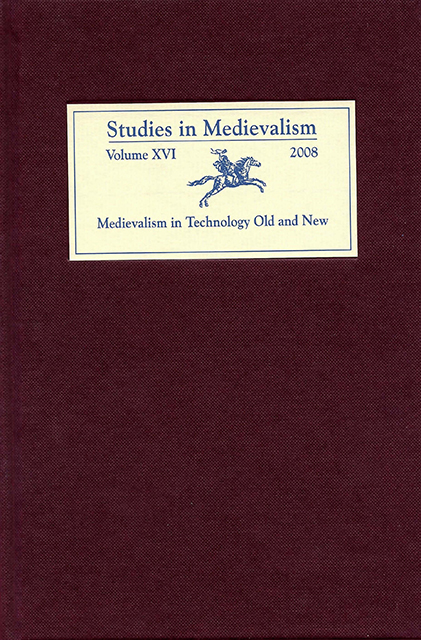Book contents
- Frontmatter
- Studies in Medievalism
- Acknowledgments
- Contents
- Volume XVI 2008
- Illustrations
- Editorial Note
- Contes du Style des Troubadours: The Memory of the Medieval in Seventeenth-Century French Fairy Tales
- A Ritual Failure: The Eglinton Tournament, the Victorian Medieval Revival, and Victorian Ritual Culture
- An Eastern Medieval Revival: Byzantine Art and Nineteenth-Century French Painting
- I Am Weary of That Foolish Tale: Yeatss Revision of Tennysons Idylls and Ideals in Time and the Witch Vivien
- The Doughboy Comes to Chartres: Stars and Stripes and the Middle Ages
- Constructing Difference: The Guidonian Hand and the Musical Space of Historical Others
- An Introduction to Medievalist Video Games
- Medieval and Pseudo-Medieval Elements in Computer Role-Playing Games: Use and Interactivity
- Romancing the Game: Magic, Writing, and the Feminine in Neverwinter Nights
- Revising the Future: The Medieval Self and the Sovereign Ethics of Empire in Star Wars: Knights of the Old Republic
- Promises of Monsters: The Rethinking of Gender in MMORPGs
- Contributors
An Eastern Medieval Revival: Byzantine Art and Nineteenth-Century French Painting
Published online by Cambridge University Press: 10 March 2023
- Frontmatter
- Studies in Medievalism
- Acknowledgments
- Contents
- Volume XVI 2008
- Illustrations
- Editorial Note
- Contes du Style des Troubadours: The Memory of the Medieval in Seventeenth-Century French Fairy Tales
- A Ritual Failure: The Eglinton Tournament, the Victorian Medieval Revival, and Victorian Ritual Culture
- An Eastern Medieval Revival: Byzantine Art and Nineteenth-Century French Painting
- I Am Weary of That Foolish Tale: Yeatss Revision of Tennysons Idylls and Ideals in Time and the Witch Vivien
- The Doughboy Comes to Chartres: Stars and Stripes and the Middle Ages
- Constructing Difference: The Guidonian Hand and the Musical Space of Historical Others
- An Introduction to Medievalist Video Games
- Medieval and Pseudo-Medieval Elements in Computer Role-Playing Games: Use and Interactivity
- Romancing the Game: Magic, Writing, and the Feminine in Neverwinter Nights
- Revising the Future: The Medieval Self and the Sovereign Ethics of Empire in Star Wars: Knights of the Old Republic
- Promises of Monsters: The Rethinking of Gender in MMORPGs
- Contributors
Summary
As the nineteenth century progressed, interest in medieval romance, literature, and art intensified, especially in France. The reasons for this were varied, but certainly the revival spirit of French Catholicism at mid-century and the ubiquitous search for a deeper spirituality at the end of the century contributed significantly to this attraction to the medieval period. In addition, the growing nationalistic fervor in nineteenth-century France encouraged an increased fascination with the French Middle Ages. While the western Middle Ages were clearly of interest to the nineteenth-century French, the eastern medieval world, specifically Byzantium, was also becoming a topic of great attraction and curiosity. The interest in Byzantine art, architecture, and history resulted in a plethora of printed journals, books, and other publications that featured engravings of many Byzantine monuments, and motivated many to travel to Italy, Greece, and Turkey, where they encountered Byzantine monuments first-hand. Whether seen in person or through representations, such an acquaintance with Byzantine images encouraged and inspired a number of nineteenth-century artists. For example, mid-century mural painters and the late-century artists who called themselves “the Nabis” (“the Prophets”) each expressed a distinctly Byzantine influence through iconographic choices, formal compositions, and painting techniques.
At mid-century, French artists were creating apsidal and nave murals that reflected, if not copied, forms from Early Christian and Byzantine churches. The church of Saint-Vincent-de-Paul in Paris provides an excellent example of the reappropriation of what was understood at the time as the Byzantine style. Jakob-Ignaz Hittorff inherited the patronage of the building of Saint-Vincent-de-Paul from his father-in-law, Jean-Baptiste Lepère. When Hittorff took over the construction of the church, he remodeled the structure to reflect the form of Early Christian basilicas and desired a decorative program that would match this architectural style.
In 1848, Hittorff chose François-Edouard Picot to decorate the apse of Saint-Vincent-de-Paul. In a letter dated August 14, 1848, Hittorff urged Picot to study the images in L’Architecture moderne de la Sicile (1835), Hittorff 's own book, and to use the illustrations in that volume to inform the compositions for the church. In his apsidal painting, Picot displays Christ seated on a cushioned-throne. Cross-nimbed, clad in a blue tunic, and wrapped in a red cloak, Christ blesses with an outstretched right hand while he holds a book in his left. This composition is very similar to Byzantine representations of Christ the Pantocrator, which are very common in the art of Byzantium.
- Type
- Chapter
- Information
- Studies in Medievalism XVIMedievalism in Technology Old and New, pp. 46 - 66Publisher: Boydell & BrewerPrint publication year: 2008



